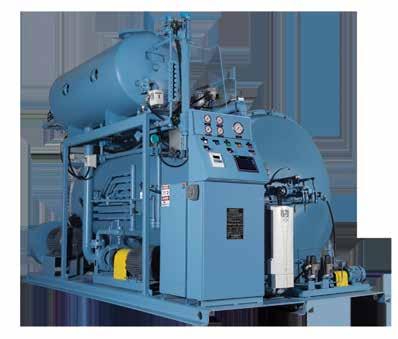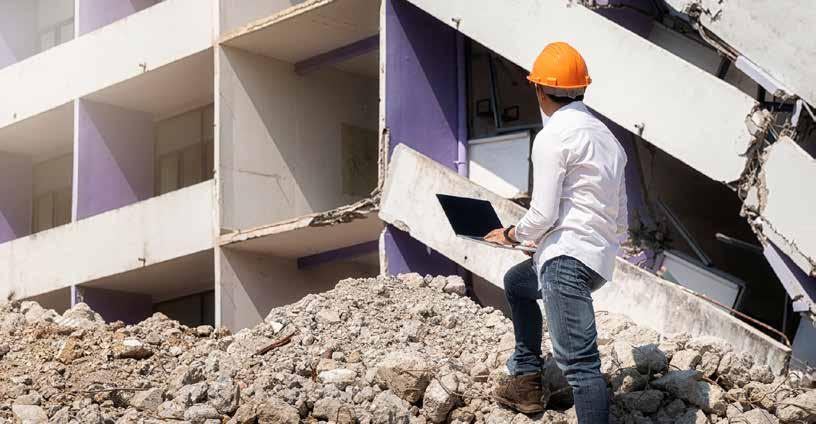
3 minute read
Journey to Net-Zero
Working toward the low-carbon heating plant
By Ian Jarvis
Advertisement
With governments across North America declaring climate emergencies, achieving netzero within 30 years is becoming a common goal and commitment. Meeting such low-carbon targets requires deep reductions in energy and emissions, far beyond what is being achieved with current approaches.
The transition to the low-carbon future will drive fundamental changes in society and the economy. Nowhere will the effects be felt more than in healthcare. The biggest changes in hospitals will come in the power plant, with a shift away from steam to hot water and a new focus on comprehensive heat recovery.
Recently opened hospitals in Ontario provide insight and direction on where the 21st century low-carbon heating plant is headed. Toronto’s Humber River Hospital features heat recovery chillers and hot
water boilers. Only a small steam plant is used to process loads and for humidification. Peel Memorial Centre for Integrated Health and Wellness has an extensive geothermal installation that draws heat from the ground to further offset natural gas consumption. Both of these facilities operate at less than half the gas use intensity of the best of their peers with traditional, steam-centred heating plants.
The challenge for hospitals is how to transition from their existing plant configuration to this low-carbon future. It is not economically feasible to simply rip out a functioning plant and replace it with a well-integrated new system.
The Greening Health Care program has embarked on a ‘practical pathways’ applied research initiative with a number of member hospitals and industry leaders aimed at developing and demonstrating the transition and, at least, life cycle cost. This work will be featured at the annual sustainability forum, Greening Health Care, to be held June 10-11, at the Metro Toronto Convention Centre. Headwaters Health Care Centre is among 60 hospitals taking part in this program. The healthcare facility’s low-carbon design brief and financial model will be showcased at the forum, which will take place alongside the inaugural Real Estate Management Industry (REMI) Summit whose goal is to deliver critical insight into the real issues commercial building owners and facility managers face today.
PATHWAY TO SAVINGS While every heating plant is different in terms of age, condition and configuration, the core principles of the ‘practical pathways’ roadmap are the same.
The first is to maximize the building systems’ efficiency to optimize peak and partial heating loads while lowering utility costs and emissions. This work begins with enhanced operation and control of air handling and hydronic systems, and then looks to all cost-effective retrofits.
Next is to identify and quantify every source of recoverable heat across the hospital, including air or water-cooled medical equipment and refrigeration units, exhaust air and discharged water. The healthcare facility must determine the most practical way to harvest this heat and bring it to a usable grade and location, generally through the chilled water system.
Then there is the need to document the age and condition of each part of the existing heating plant, as well as any equipment that is a target for heat recovery. Cross reference with the Facility Condition Assessment Program schedule within the Health Infrastructure Renewal Fund and verify replacement costs and timelines.
Afterward, develop the conceptual design for the ultimate low-carbon plant with schematics, equipment schedules,
budget costs, and energy and emissions reduction estimates.
Finally, adjust asset management and capital planning so that every power plant-related capital project becomes a step toward the ultimate plant design and performance over time.
The low-carbon future presents opportunities as well as challenges. Carbon pricing can be expected to rise considerably, adding to pressures on utility budgets. At the same time, carbon funding is expected to flow back to hospitals to help pay the capital costs involved in the transition. Hospitals prepared with shovel-ready projects that can deliver deep emissions reductions will do well.
Ian Jarvis is executive director of the Climate Challenge Network, a non-profit organization managing collaborative, data-driven sectoral programs for hospitals, municipalities and school boards. Its work focuses on deep, sector-wide greenhouse gas emissions reductions, energy and water efficiency leadership, and maximizing economic returns on investment. Ian is a recognized business leader and authority on energy efficiency, green buildings and low-carbon performance. He can be reached at 416-915-1530 or ijarvis@climatechallengenetwork.org.












